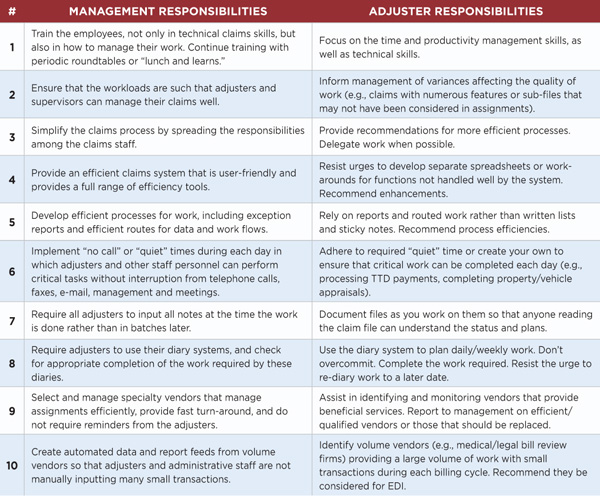Several years ago I lived in Knoxville, Tenn., in beautiful eastTennessee. There was a place in the middle of the city where twomajor interstate highways, I-75 and I-40, came together. The volumeof traffic going through this major intersection had exceeded theoriginal intent of the design and construction. Truckers talking ontheir CB radios had a special name for this unfortunate trafficengineering nightmare — "Malfunction Junction." It was so namedbecause truckers and other motorists would sit for long periods oftime before they were able to come out the other side and continueon the way to their destinations. Fortunately improvements werelater made that eventually relieved this area of much of itstraffic woes, making the area somewhat more car- anddriver-friendly.
|In the claims world, we have another area that can sometimes bea "Malfunction Junction." This is the point where claims managementresponsibilities come together, whether they are performed by staffor outsourced to service providers — the mind and desk of theadjuster.
|In many cases the traffic flows smoothly and in the rightdirection through the adjuster, and the claims are resolvedefficiently and effectively. However, especially in the case ofsignificant or complex losses involving multiple parties, thetraffic may not flow as freely through the adjuster as it should.These delays or blockages primarily occur because of one of tworeasons:
The adjuster's caseload is too high for the adjuster to managethe claims assignments well, or
The adjuster is not efficiently managing his/her time and workwhile trying to direct traffic from these other avenues.
The outcomes of these delays or blockages are:
Claims that remain open longer than they should,
Misdirection that results in some of the parties heading off inthe wrong direction, or
Collisions between the parties.
The most troubling outcome from a financial perspective is thatthese result in greater cost in both claims costs and lossadjustment expenses.
||What Causes these Malfunctioning Junctions?
|Sometimes malfunctions occur because managers and supervisorsrequire or allow their adjusters to carry workloads that exceedreasonable levels, dispatching more traffic through the junctionthan appropriate. Reasonable levels vary by line of insurance, typeof claim, efficiency of the workflow and the claims system,experience of the adjusters, and many other reasons. However, asmore TPAs and insurers try to differentiate themselves from theircompetitors, they realize that poor claims service due to excessiveworkloads is not the type of differentiation they want. Therefore,many of them are reducing and limiting the number of claims orfeatures that their adjusters handle. Also, clients are insistingon more manageable workloads, and these requirements often findtheir way into the special handling instructions that the claimsadministration and client negotiate.
|
The issue I see most often in the course of claims audits andefficiency assessments is that many adjusters and supervisors lackgood time management skills, and also fail to manage their workefficiently. Even in cases with low caseloads, adjusters oftencomplain that they do not have sufficient time to properly managethe claims that they are assigned.
|This also occurs when much of the work that was previouslyperformed by adjusters has been farmed out to vendors. In somecases, the presence of specialty vendors aids the adjuster becausethe vendors perform tasks for which they may be better trained.However, in some cases the coordination of these various servicesrequires more organization and execution, resulting in anothermalfunction junction at the adjuster if they are not properlymanaged.
|Lastly, in some cases the adjusters have assigned work tospecialty vendors and have abdicated their responsibilities,relying on the vendors to update them and handle various parts ofthe claim with inadequate direction. Unfortunately, this oftenleads to poor results, even when the vendors may be fully qualifiedand are conscientious about performing their duties.
|Insurers or TPAs may have also failed to efficiently developtheir claims workflows, resulting in excessive hand-offs, redundantactivities, staff/work mismatches, and other issues that requireadjusters to perform many manual tasks that should be automated.For example, an adjuster or supervisor may be required to review along list of open claims to identify those that need large lossreports, rather than relying on reports that identify those claimsand automatically route them to the person with the appropriateauthority.
|One of the greatest efficiency-stealers that I have noted,however, is when adjusters fail to properly plan their workdays.Rather than have a daily or weekly work plan, adjusters let themany daily distractions take them away from their most importantresponsibilities — planning and resolving the claims.
|How to Avoid or Mitigate the Malfunction
|There are many efficiency experts who provide excellent guidanceon how to work more productively. Execution of theserecommendations, however, is the most difficult part of using thetools.
|What can insurers, TPAs, or self-administered claims programs doto help their adjusters manage their time and work better? What canadjusters to improve the quality of their daily lives, and providehigher-quality service with better results? The following matrixprovides some recommendations, which are categorized by managementor adjuster responsibilities:
|If management has established a better environment forefficiency and productivity and the adjusters have been properlytrained, then the most difficult part begins — discipline andexecution. Management and the adjusters must work hard to adhere tothese principles and procedures. They must identify and fixdistractions that enter their daily lives, and management shouldformalize the requirements in association with the company's "bestpractices." The use of these tools to create more effective workenvironments will allow management and the adjusters to avoid"malfunction junction" and get traffic going in the rightdirections.
Want to continue reading?
Become a Free PropertyCasualty360 Digital Reader
Your access to unlimited PropertyCasualty360 content isn’t changing.
Once you are an ALM digital member, you’ll receive:
- All PropertyCasualty360.com news coverage, best practices, and in-depth analysis.
- Educational webcasts, resources from industry leaders, and informative newsletters.
- Other award-winning websites including BenefitsPRO.com and ThinkAdvisor.com.
Already have an account? Sign In
© 2024 ALM Global, LLC, All Rights Reserved. Request academic re-use from www.copyright.com. All other uses, submit a request to [email protected]. For more information visit Asset & Logo Licensing.








